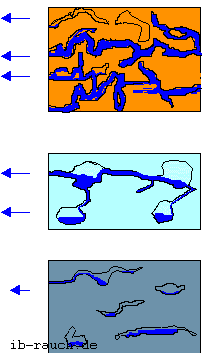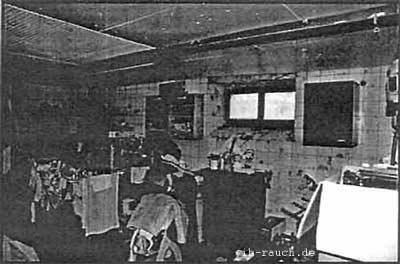The cellar waterproofing, the brick drying as well as the causes of damp cellars
Especially for old buildings, the rehabilitation of damp cellar walls is a problem. In many cases, an "ascending moisture" is suspected in the case of a high wall moisture in the cellar. However, the hygroscopic properties of the salts and the formation of condensation on the cooler wall surface are underestimated. This is the case in summer, when warmer air flows into the basement rooms. In this article the term moisture is explained in more detail. Furthermore, the causes of damp masonry are described and the individual sealing methods for the drying of masonry are compared.
Contents
1. General information on moisture
2. Causes of moisture in the masonry
3. Possibilities of drying a drying plant
4. Vertical procedures for interrupting capillary water transport
5. Horizontal procedures for interrupting capillary water transport
5.1. Mechanical procedures
5.1.1. Sectional splaying by hand
5.1.2. Sectional surveying
5.1.3. Masonry separation by oblique cut-off, machine
5.1.4. Insertion of stainless steel sheet, machine
5.1.5. Undertaking procedures
5.2. Cross-section sealing by pressureless and pressurized injection processes
5.3. Electrophysical / electrokinetic methods
5.3.1. Principle of electrochemical desalination and reduction of capillary water transport
5.3.2. Passive procedures
5.3.3. Active procedure
5.3.4. Electrodeless electroosmosis
6. Salts in masonry and the role of plaster
6.1. Salts in the masonry (general)
6.2. Mode of action of sacrificial plaster or plaster cleaning
6.3. Cement-bound plaster (so-called barrier plaster)
6.4. Restoration plasters
7. Drying processes
7.1. Introduction
7.2. Drying equipment
7.3. Sensor controlled ventilation
7.4. Drying with infrared radiation
7.5. Microwave Principle
7.6. Temperature controlled heating rod technology
Literature Notes and Standards
1. General information on moisture
The term moisture or moisture is the content of water vapor in atmospheric air. Each building material is in a moisture equilibrium to its environment. The practical moisture content (Table 1) will depend on the location, whether in the basement, roof, bath or on the south side. The location influences the amount of moisture in the construction.
Table 1: Practical moisture content of building materials and components
| building material | Practical moisture content Volume-related [vol%] |
|---|---|
| Bricks | about 1,5 |
| Lime-sandstone | about 5,0 |
| Concrete with a closed structure with dense or porous aggregates | about 5,0 |
| Lightweight concrete with bulky structure with dense aggregates according to DIN 4226 part 1 | about 5,0 |
| Lightweight concrete with bulk aggregate structure with porous aggregates according to DIN 4226 part 2 | about 4,0 |
| Aerated concrete | 3,5 |
| Gypsum, anhydrite | Circa 2,0 |
| Complete brick | 1 ... 2,5 |
| Hollow bricks | 1,5 ... 4,0 |
| Interior cleaning | 1 ... 10 |
| Exterior cleaning | 1 ... 7 |
| Inorganic materials in unmounted Schüttung; Expanded rock-glass (for example expended perlit) | 5,0 (claim-covered) |
| Inorganic substances in bulk; Expanded glass (for example, expanded perlite) | 5,0 (based on the mass) |
| Mineral fiber insulation of glass, stone, blast furnace slag | 5,0 (based on the mass) |
| Foam glass | 0 (based on the mass) |
| Wood, plywood, chipboards, wood fiber boards, lightweight wooden boards, reed boards and reed mats, organic fiber insulation | 15,0 (based on the mass) |
| Vegetable fiber insulation from sea grass, wood fibers, peat fibers andCoconut fibers and other fibers | 15,0 (based on the mass) |
| Cork insulation | 10,0 (based on the mass) |
| Foam plastics Polystyrene, polyurethane (hard) | 5,0 (based on the mass) |
Moisture is stored in all capillary-porous building materials. The storage of water is dynamic and often very uneven in the same construction. In the case of capillary-porous constructions, an average permanent moisture content is obtained. Wood is characterized by an equilibrium moisture. However, wood is also hygroscopic and can thus also bind from the air moisture. One differentiates:
Water vapor diffusion: The transport of water vapor through the building material.
Capillary Conductivity: The transport of liquid (water) through the building material.
Hygroscopic: The ability of a building material to absorb and bind water.
Figure 2: Moisture behavior of various building materials [6]
| Well-designed capillary system with capillaries of different diameters: High water absorption capacity, high moisture release capacity, for example bricks, plaster Closed-cell structure with few capillaries between the cells: High water absorption capacity, low moisture release capacity, eg gas concrete Structure with small, closed pores and capillaries: Low water absorption capacity, low moisture release capacity, for example heavy concrete, expanded concrete |
 |
It is easy to see from the above that 5% mass volume water has a different meaning in every building material. This means that every building, even a component with the respective building materials used, has to be assessed separately.
The binders, such as cement, lime and gypsum used in house construction, require water for their chemical setting process and the mortar itself. This water in the building construction must for the most part also be escaped and discharged. The new building did not have windows in the first winter and could dry out until spring. Or in the first 1 to 2 years, poorer families lived in the new dwellings. They had the task of living the apartment dry. Even the occupants of a house are forced to open the doors and windows and to heat in the winter for a dry building. If the building is not used for an extended period of time, it is increasingly disintegrating. A major cause of this is the moisture, which is not sufficiently removed. Economic considerations reduce construction times without meeting the necessary technological drying times. This is associated with a much too high humidity of the room air during the initial use, which often leads to mold fungus formation. 80% relative humidity and more could already often be found during renovation work in the inhabited state. Unfortunately, it is not an individual case that old facades are washed with high pressure and immediately afterwards a heat insulation composite system is applied. During this time the windows are covered with foil. It must be pointed out that, in the undisturbed moisture content of a wall, evaporation is the mechanism which counteracts water absorption. This is the only way to dry the outer wall layers.
To reduce the humidity more quickly we recommend the use of a
Room air dryer. The use is also useful, since deeper wall layers can only release their moisture according to the laws of steam diffusion. (Capillary transport is also carried out with capillary-porous building materials only with very high permeability.)
brick, clay und Wood have particularly favorable physical properties and are therefore recommended as room-enclosing building materials. Their main advantage is that they can break off short-term moisture tips, such as occur during showers.
Gypsum plaster and plaster lime plasters find a wide field of application during renovation and new construction. However, a large amount of water is also required for their processing, which must be removed again to the water of the crystal.
In an object, the interior walls were plastered with a new plaster lime plaster, sometimes up to 4 cm thick. The inadequate ventilation turned some rooms into regular dripstone caves with an interesting reddish mold covering.The bricklayer put all the blame on the material. He did not want to hear anything from a processing mistake and a bad ventilation.

But damage can also be promoted through the wrong use. Here is a picture (2005) from a cellar (built in 1910) in NRW. Just a sample of the errors. The tiles (barrier layer) prevent the moisture balance between wall and room air. The wall moisture thus rises further and further upward. The salt- and damp-damaged plaster has already dissolved, see damaged tiles. Drying in the closed building must be avoided and especially in the cellar. (On the other hand, the drying of laundry in the attic is better because the roof is not completely tight and the moisture is always removed.) In this enclosed space, neither the tiles nor the ceiling can adequately absorb the air humidity and discharge it to the outside. Not only the windows are closed and what is not visible in the picture, the cellar doors are closed and do not allow cross ventilation or air exchange with the other cellars.
All prices in this article are non-binding.
© House renovation | Building ideas | Health | eBook | Imprint | 12/2016 ![]()
